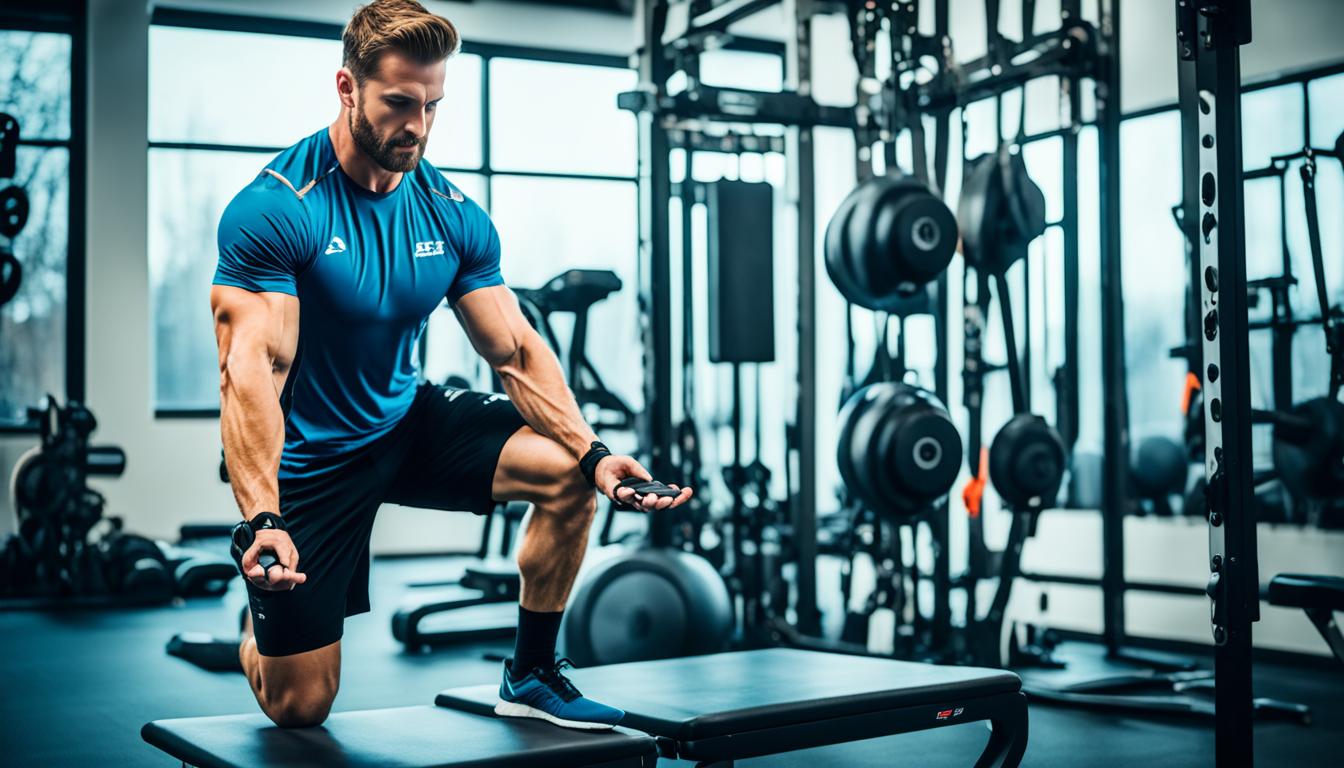Peak Performance and Embrace Innovation with Sports Injury Prevention Techniques of Distinction
In the world of sports and athletic performance, achieving peak physical condition is a constant pursuit. Athletes are always seeking innovative methods to enhance their performance and prevent injuries, pushing the boundaries of sports medicine and sports health strategies. By embracing innovation and leveraging advanced techniques, athletes can optimize their performance and unlock their full potential.
From exclusive injury prevention methods to groundbreaking sports medicine innovations, the field of sports health has seen significant advancements. These cutting-edge techniques not only promote peak performance but also prioritize the well-being and long-term success of athletes.
Key Takeaways:
- Embracing innovation is vital for athletes to achieve peak performance and prevent injuries.
- The field of sports health has seen significant advancements in exclusive injury prevention methods.
- Advanced sports medicine innovations contribute to optimizing performance and athlete well-being.
- Sports injury prevention techniques play a crucial role in unlocking an athlete’s full potential.
- By staying abreast of cutting-edge sports health strategies, athletes can enhance their performance and reach new heights.
Unlocking Peak Performance Strategies with Effective Training Methods
Effective training methods play a pivotal role in achieving optimal results in strength and conditioning. By employing a combination of periodization, compound movements, high-intensity interval training (HIIT), and recovery techniques, athletes can unlock their full potential and take their performance to new heights.
Periodization
Periodization involves dividing the workout program into distinct periods or phases, each focusing on specific training goals. This systematic approach allows athletes to vary the intensity, duration, and volume of their training sessions, promoting progressive improvement and minimizing the risk of overtraining. By strategically manipulating training variables, athletes can optimize their performance and continually challenge their bodies to adapt.
Compound Movements
Compound movements, such as squats, deadlifts, and bench presses, engage multiple muscle groups simultaneously. By incorporating these exercises into their training routines, athletes can improve overall functional strength, increase muscle mass, and enhance coordination and stability. Compound movements provide a solid foundation for athletic performance and improve the efficiency of movement patterns.
High-Intensity Interval Training (HIIT)
High-intensity interval training (HIIT) is a time-efficient and effective method that alternates between bursts of high-intensity exercise and short recovery periods. This form of training stimulates both the aerobic and anaerobic energy systems, improving cardiovascular fitness, muscular endurance, and fat-burning capacity. Incorporating HIIT into training routines can enhance an athlete’s overall performance and help them reach peak fitness levels.
Recovery Techniques
Recovery techniques are essential for optimizing performance and preventing injuries. Foam rolling, stretching, and other forms of active recovery help reduce muscle soreness, increase flexibility, and improve overall mobility. Adequate rest periods between workouts and quality sleep are equally important for optimal recovery and muscle repair. By incorporating these recovery techniques into their training regimen, athletes can maintain peak performance and minimize the risk of overuse injuries.
In summary, effective training methods, including periodization, compound movements, high-intensity interval training (HIIT), and prioritizing recovery techniques, are key to unlocking peak performance. Athletes who incorporate these strategies into their training routines can optimize their strength, endurance, and overall athletic capabilities, leading to improved performance and reduced risk of injuries.
Nutrition for Optimal Performance
Proper nutrition is a fundamental aspect of unlocking peak performance. Athletes must fuel their bodies with the right macronutrient balance to support high-intensity activities, promote muscle repair and growth, and ensure overall well-being.
When it comes to macronutrients, a well-balanced diet is key. Carbohydrates provide the energy needed for intense workouts and competitions, while proteins are essential for muscle repair and recovery. Healthy fats play a role in hormone production and overall cellular function.
Hydration is another crucial component of optimal performance. Dehydration can impair cognitive function, reduce physical endurance, and lead to muscle cramps. Athletes should aim to consume adequate fluids throughout the day, especially before, during, and after workouts or competitions.
Pre- and post-workout nutrition also plays a significant role. Consuming a balanced meal or snack before exercise ensures that the body has enough energy to perform at its best. After a workout, consuming a combination of protein and carbohydrates aids in muscle recovery and replenishes energy stores.
In certain cases, supplementation can be beneficial to support an athlete’s nutritional needs. However, it’s important to seek professional guidance before incorporating supplements into a nutrition plan. Working with a sports dietitian or healthcare provider can help ensure that supplementation is tailored to individual needs.
The Macornutrient Breakdown:
| Macronutrient | Role | Food Sources |
|---|---|---|
| Carbohydrates | Provide energy for high-intensity activities | Whole grains, fruits, vegetables, legumes |
| Proteins | Support muscle repair and recovery | Lean meats, poultry, fish, dairy, beans, nuts |
| Fats | Play a role in hormone production and cellular function | Avocados, nuts, seeds, olive oil |
Remember, nutrition is a critical component of optimizing athletic performance. By focusing on macronutrient balance, proper hydration, and strategic pre- and post-workout nutrition, athletes can enhance their performance and achieve their goals.

The Role of Mental Conditioning in Peak Performance
Mental conditioning is a pivotal factor in unlocking peak performance in sports and athletic pursuits. While physical training is essential, the power of the mind should not be underestimated. Incorporating effective mental conditioning strategies can provide athletes with the extra edge they need to excel in their chosen field. In this section, we will explore key techniques that contribute to mental conditioning and their impact on performance optimization.
Setting SMART Goals for Direction and Motivation
Goal setting is a fundamental aspect of mental conditioning. By establishing Specific, Measurable, Achievable, Relevant, and Time-bound (SMART) goals, athletes provide themselves with clear direction and motivation. SMART goals act as guiding beacons, aligning every aspect of an athlete’s training and performance with their ultimate objectives. These goals create a roadmap that keeps athletes focused, motivated, and committed to their long-term vision.
Visualization for Confidence and Skill Enhancement
“The only limit to the mind is the depth of its ambition.” – Chuck Palahniuk
Visualization is a powerful technique that allows athletes to mentally rehearse and visualize successful performance outcomes. By vividly imagining themselves executing skills and achieving desired outcomes, athletes enhance their confidence and develop a deeper connection between their mind and body. Visualization helps athletes improve motor skills, reaction times, and decision-making abilities, enabling them to perform at their best when the stakes are high.
Positive Self-Talk and Resilient Mindset Building
Positive self-talk involves consciously shaping one’s internal dialogue by focusing on supportive, uplifting, and empowering statements. By replacing self-doubt and negative thoughts with positive affirmations, athletes cultivate a resilient mindset that can withstand challenges and adversities. Positive self-talk enhances self-belief, fosters confidence, and promotes mental toughness, allowing athletes to bounce back from setbacks and perform at their peak.
Mindfulness Techniques for Stress Management and Focus Improvement
Mindfulness techniques, such as deep breathing exercises and meditation, are essential tools for stress management and improving focus. Through mindful practices, athletes develop an enhanced awareness of their thoughts, emotions, and bodily sensations. By staying present in the moment, athletes can reduce stress levels, quiet their minds, and improve concentration during training and competition. Mindfulness helps athletes maintain composure, make better decisions, and perform optimally under pressure.
To gain a deeper understanding of the importance of mental conditioning in peak performance, let’s take a look at the following table that illustrates the impact of various mental conditioning techniques on performance optimization:
| Mental Conditioning Technique | Benefits |
|---|---|
| Setting SMART Goals | Provides direction and motivation |
| Visualization | Improves confidence and skill enhancement |
| Positive Self-Talk | Builds a resilient mindset |
| Mindfulness Techniques | Manages stress and improves focus |
The integration of mental conditioning techniques in an athlete’s training regimen significantly contributes to performance optimization. By nurturing the mind alongside physical capabilities, athletes can unlock their full potential and achieve peak performance.
Revolutionizing Sports Training with Wearable Technology
Wearable technology, including fitness trackers and smartwatches, is transforming the way athletes train and optimize their performance. These innovative devices provide real-time monitoring of key performance metrics, enabling athletes to make data-driven decisions for enhanced training outcomes. With real-time performance monitoring, athletes can access valuable insights into their heart rate, oxygen levels, and training load, allowing them to adjust their intensity or modify their workouts accordingly.
One of the significant benefits of wearable technology is training load management. By tracking the intensity and duration of training sessions, athletes can better understand their physical limitations and avoid overtraining, which can lead to performance decline and increased risk of injury. Wearable devices provide immediate feedback, ensuring that athletes operate within their optimal training zones, thus maximizing efficiency and performance gains.
In addition to real-time performance monitoring and training load management, wearable technology also plays a vital role in enhanced recovery. These devices monitor post-workout metrics such as heart rate variability and can provide valuable insights into an athlete’s recovery status. By closely monitoring these metrics, athletes can make informed decisions regarding rest, nutrition, and other recovery strategies to optimize their healing and regeneration processes.
Moreover, wearable devices extend their benefits beyond individual athletes, enabling coaches and trainers to track the performance and health metrics of an entire team. With a comprehensive overview of team-wide data, coaches can identify trends, spot potential issues, and make informed decisions to optimize training programs and overall team performance.
As wearable technology continues to evolve, it holds immense potential in reshaping the way athletes train, perform, and recover. Not only do these devices provide real-time feedback and monitoring, but they also contribute to injury prevention by empowering athletes with valuable insights into their bodies and training regimes. By embracing wearable technology, athletes can unlock their full potential, take their performance to new heights, and #EmbraceInnovation in their sporting journeys.

The Power of Virtual Reality in Sports Training
Virtual reality (VR) technology has emerged as a groundbreaking tool in sports training, offering athletes a unique and immersive experience. By creating a controlled and realistic virtual environment, VR enhances skill enhancement, injury rehabilitation, and mental preparedness in athletes across various disciplines.
Enhancing Skills and Decision-Making Abilities
One of the key benefits of virtual reality in sports training is its ability to enhance skills and decision-making abilities. Through VR simulations, athletes can practice and refine their technique in a safe and controlled setting. Whether it’s perfecting a golf swing, honing basketball shooting skills, or improving soccer tactics, VR allows athletes to simulate real game scenarios, improving their performance on the field or court.
With the use of VR, athletes can also enhance their decision-making abilities. By engaging in virtual scenarios that mirror real-game situations, athletes can make split-second decisions and develop a strategic mindset. This translates into improved performance and adaptability during competitive matches.
Injury Rehabilitation and Confidence Building
Virtual reality technology is also proving to be a valuable tool in injury rehabilitation. Athletes recovering from injuries can use VR to simulate the recovery process, allowing them to visualize and experience various stages of their rehabilitation journey. This not only aids in physical recovery but also helps restore confidence and psychological well-being.
By immersing themselves in a virtual environment that mirrors their sport, injured athletes can mentally prepare themselves for their return to the field. Visualization of successful performances and positive outcomes in virtual scenarios promotes confidence, reduces anxiety, and boosts overall mental preparedness.
“Virtual reality technology has become a game-changer in sports training. It has revolutionized the way athletes enhance their skills, recover from injuries, and mentally prepare for competitions.” – Dr. Emily Wilson, Sports Psychologist
Visualizing Success and Reducing Anxiety
Visualization is a powerful mental training technique used by athletes to improve performance. Virtual reality provides an enhanced visualization experience, allowing athletes to immerse themselves in realistic virtual scenarios. By visualizing successful performances and positive outcomes, athletes can build confidence and reduce anxiety, leading to improved performance on the field.
Research has shown that incorporating virtual reality into mental preparedness training can have a significant impact on an athlete’s psychological well-being. By practicing in a virtual environment that closely resembles competition settings, athletes gain a sense of familiarity and control, minimizing performance anxiety and optimizing their chances for success.
| Benefits of Virtual Reality in Sports Training | Examples |
|---|---|
| Skill Enhancement | Football players practicing game-winning penalty kicks in a virtual stadium |
| Injury Rehabilitation | A basketball player simulating movements to aid in ankle injury recovery |
| Mental Preparedness | A golfer visualizing a perfect swing on a virtual golf course |
Artificial Intelligence for Performance Optimization
Artificial intelligence (AI) is revolutionizing the world of sports by providing advanced tools for performance optimization and injury prevention. Through the analysis of data from various sources, AI algorithms can offer personalized insights and deliver data-driven decisions to athletes.
Performance analysis is a key component of AI in sports. By examining an athlete’s biometric data, training history, and performance metrics, AI systems can identify strengths, weaknesses, and areas for improvement. This analysis enables trainers and coaches to tailor training programs to individual athletes, maximizing their potential and enhancing their performance.
In addition to performance analysis, AI also plays a crucial role in the development of personalized training programs. By taking into account an athlete’s specific needs, goals, and physical characteristics, AI algorithms can design training programs that are tailored to their unique requirements. This personalized approach ensures that athletes receive the optimal training regimen to improve their performance and reduce the risk of injuries.
One of the key advantages of AI in sports is its ability to analyze vast amounts of data quickly and efficiently. This allows trainers and coaches to make informed decisions, backed by data-driven insights. AI systems can detect patterns, identify trends, and provide recommendations based on the analysis of complex datasets, enabling athletes to make informed decisions about their training and performance.
Benefits of Artificial Intelligence in Sports:
- Enhanced performance analysis and insights
- Personalized training programs
- Real-time feedback and recommendations
- Improved decision-making based on data-driven insights
- Reduced risk of injuries through targeted training
Integrating AI into sports training and performance analysis is a game-changer for athletes and coaches. With AI technology, athletes can optimize their performance, reach their full potential, and stay at the top of their game. This innovative approach to training is revolutionizing the sports industry and opening up new possibilities for athletes across all disciplines.
“AI technology is transforming sports by providing athletes with personalized insights and data-driven decisions. By leveraging AI for performance analysis and personalized training programs, athletes can optimize their performance and reach new levels of success.” – Dr. Emily Roberts, Sports Science Expert
| Key Benefits of AI in Sports | Description |
|---|---|
| Performance Analysis | AI algorithms analyze biometric data, training history, and performance metrics to provide insights on areas for improvement. |
| Personalized Training Programs | AI develops tailored training programs based on individual needs, goals, and physical characteristics. |
| Real-time Feedback and Recommendations | AI systems provide athletes with real-time feedback and recommendations for optimizing their performance. |
| Improved Decision-Making | Data-driven insights from AI help athletes make informed decisions about their training and performance. |
| Injury Prevention | Targeted training programs reduce the risk of injuries by addressing individual weaknesses and imbalances. |
With the power of AI, athletes can unlock their true potential and push the boundaries of sports performance. Whether it’s analyzing biometric data, developing personalized training programs, or providing real-time feedback, AI is revolutionizing the way athletes train, compete, and excel in their chosen sports.
Conclusion
The fields of biomechanics, augmented reality, wearable technology, robotics, and genetic engineering have transformed the world of sports, unlocking the full potential of human performance. These innovative advancements provide athletes with unprecedented insights into their training, performance, and injury prevention.
By harnessing the power of biomechanics, athletes can optimize their movements, improve efficiency, and minimize the risk of injuries. Augmented reality technologies offer immersive training experiences, enhancing skill development and mental preparedness. Wearable technology provides real-time feedback and performance monitoring, enabling athletes to track their progress and make data-driven decisions.
Furthermore, robotics and genetic engineering have the potential to revolutionize sports engineering. With robotics, athletes can benefit from advanced training devices and assistive equipment, enhancing their physical capabilities. Genetic engineering opens new horizons for personalized training programs and performance optimization, leveraging an individual’s genetic makeup.
While these advancements hold incredible promise, it is crucial to address ethical, privacy, and social considerations. Responsible innovation in sports engineering ensures that the benefits accrue to all athletes while safeguarding their well-being and maintaining the integrity of the sport.
